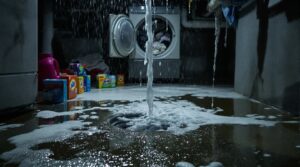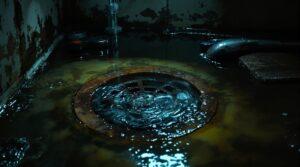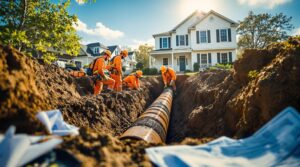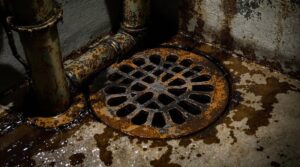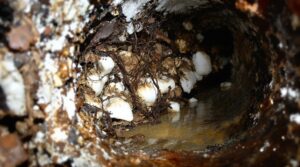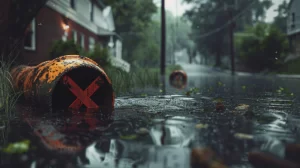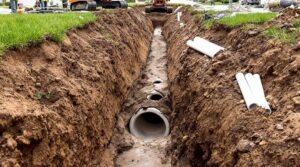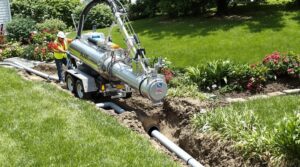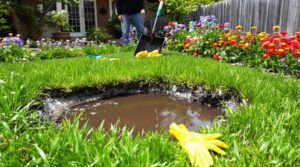When toilets and showers clog simultaneously, this typically indicates a blockage in the main sewer line rather than individual fixture problems. Common causes include accumulated debris, tree root intrusion, or improper disposal of non-flushable items. Immediate action requires shutting off the main water supply and contacting a professional plumber for diagnostic services. Advanced clearing techniques like HydroScrub or mechanical augers can resolve the blockage. Understanding the full scope of available solutions helps prevent future occurrences.
Key Takeaways
- Multiple fixtures clogging simultaneously often indicates a main sewer line blockage affecting the shared drainage system.
- Tree roots, accumulated debris, and improper disposal of non-flushable items are common causes of simultaneous clogs.
- Shut off the main water supply immediately and avoid using any plumbing fixtures until professional help arrives.
- Professional plumbers use video inspections and hydro-jetting techniques to diagnose and clear severe blockages effectively.
- Regular drain maintenance, proper disposal habits, and quarterly inspections help prevent simultaneous fixture clogs.
Understanding Common Drain System Connections
When toilets and showers experience simultaneous drainage problems, the issue often stems from their shared connection to a main sewer line. This interconnected plumbing system design means that blockages occurring in the main line can affect multiple fixtures simultaneously, creating widespread drainage issues throughout the bathroom.
In residential plumbing systems, shower drains and toilets typically converge into a larger main drain pipe before connecting to the household's primary sewer line. This configuration makes these fixtures particularly vulnerable to upstream obstructions.
When a clogged drain occurs in the main sewer line, it creates a chain reaction affecting all connected fixtures above the blockage point. Common causes include accumulated debris from shower usage, such as hair and soap scum, combining with toilet waste and foreign objects. This buildup prevents water from flowing freely, leading to backups that can be both inconvenient and damaging. In worst-case scenarios, the blockage can extend beyond the initial site, impacting the overall efficiency of the drainage system in basement floors, causing flooding or water damage in those areas. Prompt attention to these issues is crucial to maintain a functional plumbing system and protect your home from costly repairs.
Additionally, external factors like tree root infiltration can compromise the main sewer line's integrity, leading to more complex drainage problems that require professional intervention.
Signs of a Main Sewer Line Blockage
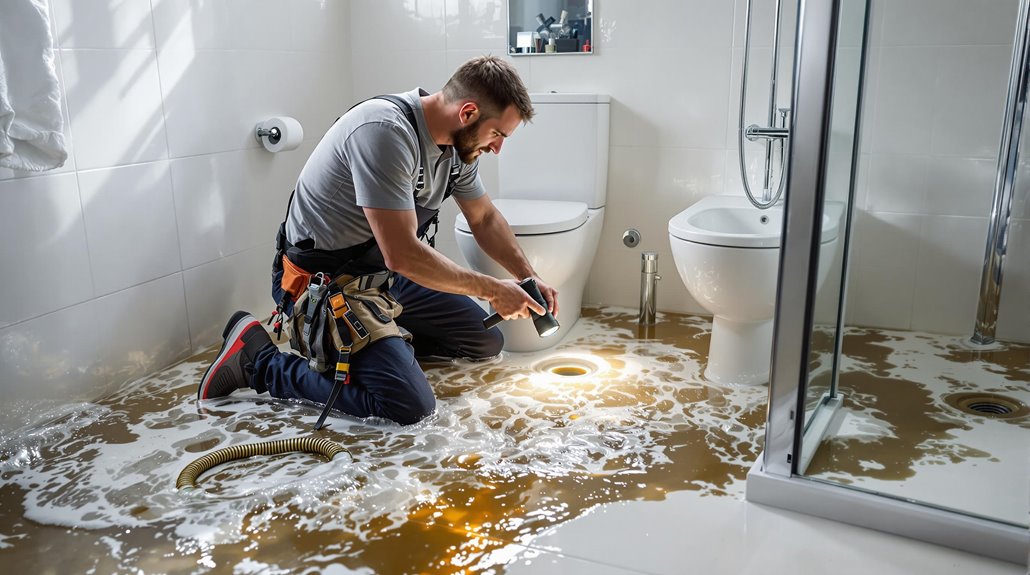
Identifying a main sewer line blockage requires homeowners to recognize several telltale indicators that distinguish systemic problems from isolated fixture issues. When multiple plumbing fixtures exhibit simultaneous drainage problems, this often signals a significant obstruction in the main sewer line rather than individual clogs.
Key warning signs of a main line blockage include:
- Water backing up between fixtures, particularly when water from the shower rises during toilet flushing.
- Persistent foul odors emanating from multiple drains, indicating trapped sewage and potential clogged vent issues.
- Gurgling sounds from drains when using other fixtures, suggesting air pressure problems in the system.
These symptoms typically occur together and worsen over time if left unaddressed.
When homeowners observe these interconnected issues, particularly involving both the toilet and shower, it indicates a problem requiring professional evaluation of the main sewer line rather than attempting isolated fixture repairs.
Immediate Steps to Prevent Further Damage
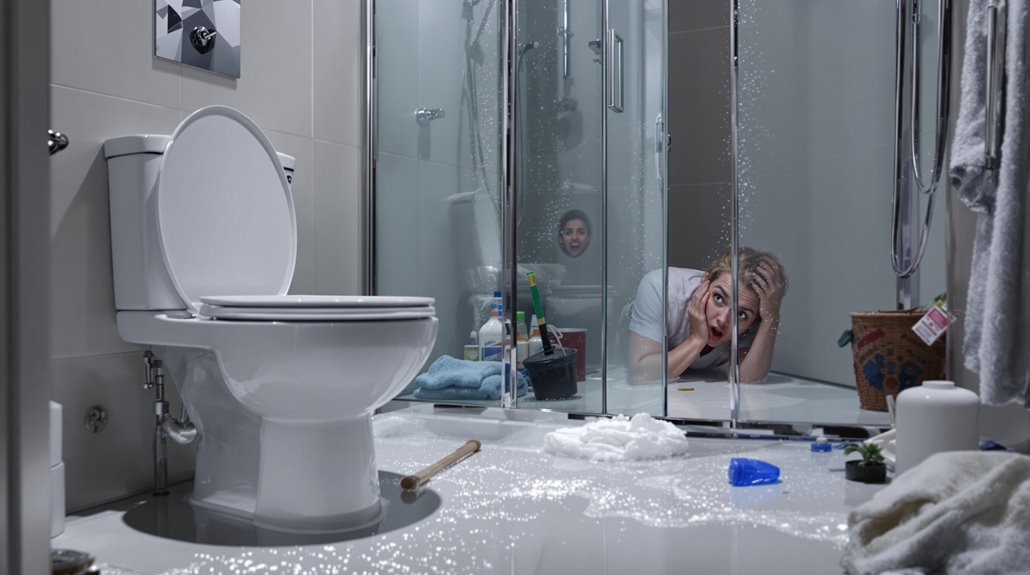
When facing a toilet and shower clog, the initial critical step is to immediately shut off the main water supply valve to prevent additional water damage and potential sewage backup.
Standing water must be promptly removed from affected areas using a wet vacuum or absorbent materials to minimize contamination risks and assess the extent of the blockage.
Sealing adjacent drain openings with duct tape or rubber stoppers helps maintain proper pressure for diagnosis while preventing cross-contamination between fixtures during the repair process.
Turn Off Water Supply
A swift response to toilet and shower clogs starts with shutting off the main water supply to prevent potential flooding and sewage backup. The main shutoff valve's location near the water meter or where the main line enters the house must be identified quickly for immediate action when needed.
- Locate and turn off the main water valve immediately upon noticing simultaneous clogs in toilet and shower.
- Avoid using any plumbing fixtures after shutting off the water supply to prevent further accumulation.
- Contact a professional plumber while maintaining the water supply in the off position.
Early detection of slow drainage provides valuable time to turn off water supply before sewage backing becomes severe.
This preventive measure creates ideal conditions for a plumber to assess and resolve the underlying cause effectively.
Clear Standing Water First
Removing standing water serves as the essential first step in addressing simultaneous toilet and shower clogs. This initial action prevents potential sewage backup and additional strain on the plumbing system.
A wet/dry vacuum provides the most effective method for safely extracting water from affected areas while minimizing contamination risks.
When dealing with significant water accumulation, shutting off the main water supply becomes important to prevent further overflow while addressing the clogged drain situation. Property owners should avoid using plungers or other tools while standing water is present, as this can force water into connecting drains and worsen the backup.
Once the water is cleared, a thorough visual inspection can reveal obvious blockages or buildup, helping determine whether professional intervention is necessary for resolving deeper sewer line issues.
Seal Adjacent Drain Openings
To prevent sewage backup from spreading throughout the plumbing system, homeowners must immediately seal all adjacent drain openings using thick rags or waterproof tape.
During this process, it's essential to guarantee all water fixtures remain off to minimize overflow risks and potential damage to sewer pipes.
Key steps when sealing adjacent drain openings:
- Quickly identify and seal all connected drains in bathrooms, kitchen, and laundry areas
- Document visible signs of backup, unusual odors, and water accumulation for plumbing professionals
- Avoid using chemical drain cleaners, which can create hazardous fumes when mixed with sewage
This temporary measure helps contain the problem while awaiting professional assessment.
Proper sealing prevents cross-contamination between different areas of the home's plumbing system and provides valuable time to arrange for expert intervention.
Professional Diagnostic Methods
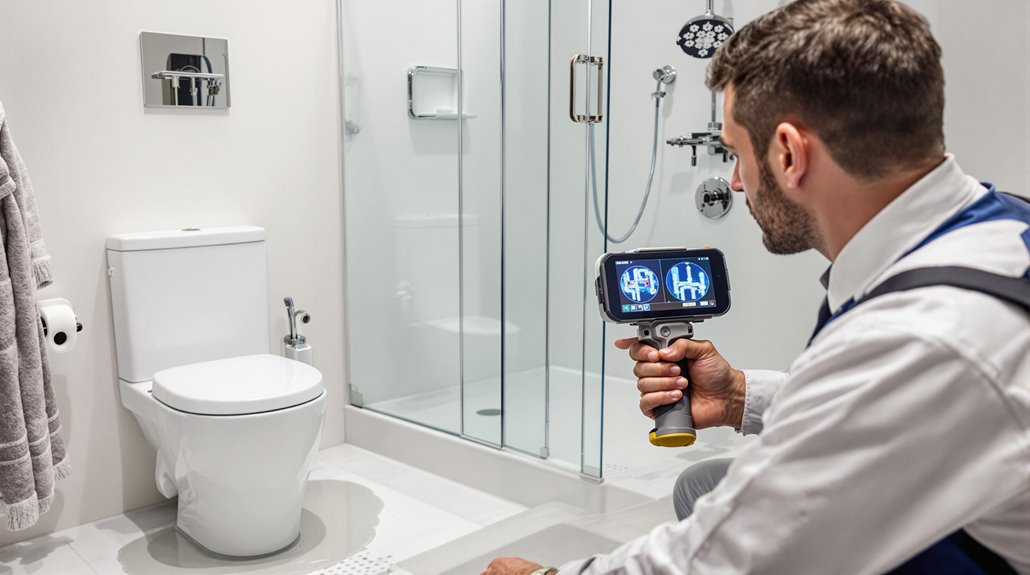
Professional plumbers employ sophisticated diagnostic techniques to accurately assess toilet and shower clogs before implementing solutions.
Using advanced diagnostic methods like video inspections, they can precisely locate and identify the nature of blockages within the sewer lines without destructive digging or exploratory work.
These professional diagnostics enable plumbers to systematically evaluate the entire plumbing system, examining the interconnections between drains to determine if simultaneous clogs indicate a more serious main sewer line problem.
The thorough analysis includes checking for common underlying causes such as tree root intrusion, accumulated grease deposits, or improper items causing obstructions.
This detailed diagnostic approach not only guarantees accurate problem identification but also provides homeowners with transparent pricing information before any repair work begins, eliminating unexpected costs and guaranteeing the most effective solution is implemented for the specific clogged drain situation.
Advanced Clearing Techniques
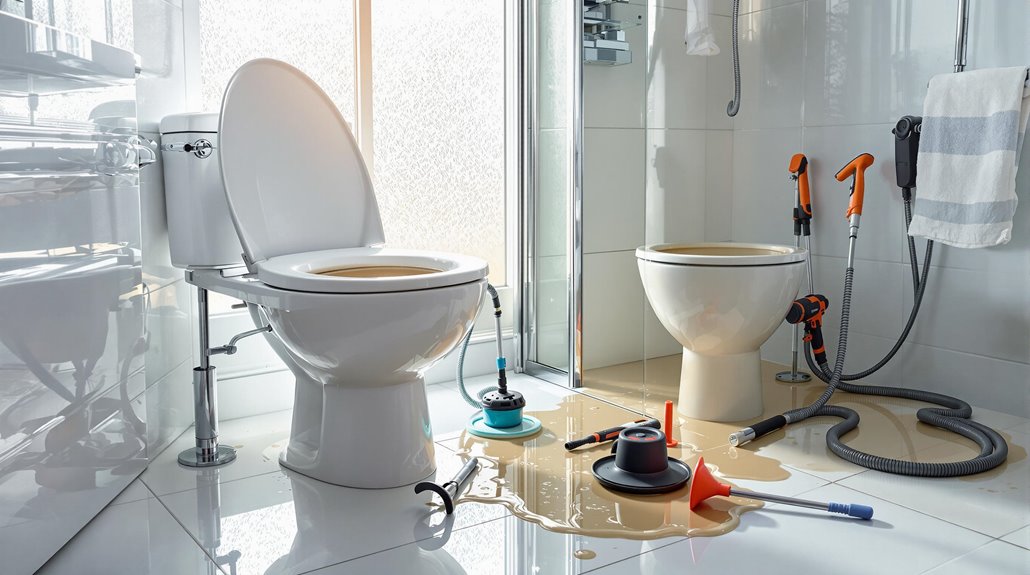
Modern plumbing technology has revolutionized the approach to clearing stubborn drain blockages through advanced techniques that combine precision diagnostics with powerful clearing methods.
These sophisticated solutions address complex clogs affecting multiple fixtures simultaneously, ensuring long-term effectiveness while minimizing structural impact.
- HydroScrub services deploy high-pressure water jets to remove accumulated debris, grease, and tree root intrusions from sewer lines.
- Trenchless pipe lining creates a seamless, protective barrier within existing pipes, preventing future blockages and leaks.
- Pipe bursting technology installs new high-density polyethylene pipes while simultaneously removing damaged sections, maximizing flow capacity.
Advanced clearing techniques utilize video inspection systems to pinpoint obstruction locations, enabling targeted remediation strategies.
Professional plumbers employ specialized equipment like mechanical augers and snaking tools to methodically clear blockages beyond standard access points, preserving the plumbing system's structural integrity while resolving complex drainage issues.
Prevention and Maintenance Strategies
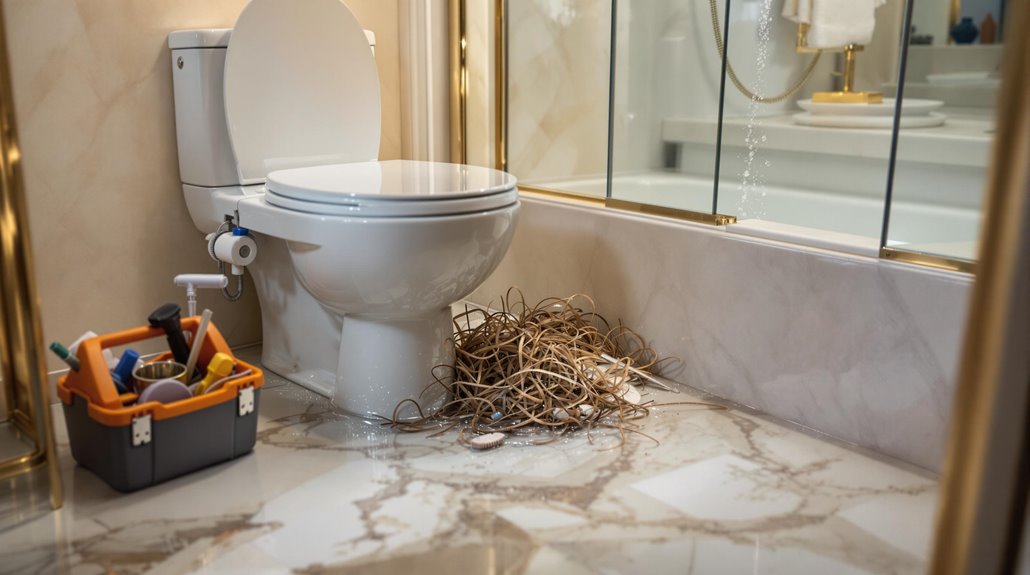
Effective prevention and maintenance strategies form the cornerstone of a well-functioning plumbing system, particularly when addressing interconnected toilet and shower drain issues. Regular inspections of sewer lines combined with proper maintenance protocols markedly reduce the risk of simultaneous clogs.
| Maintenance Area | Prevention Method | Frequency |
|---|---|---|
| Drain Systems | Hair trap cleaning | Weekly |
| Sewer Lines | Hot water flushing | Monthly |
| Vent Pipes | Debris removal | Quarterly |
A thorough maintenance approach includes implementing strict policies against flushing inappropriate materials and installing preventive devices like hair traps in shower drains. Professional plumbing inspections should be scheduled regularly to identify potential issues before they develop into major problems. The maintenance of vent pipes is equally vital, as proper airflow considerably impacts the entire drainage system's functionality. Additionally, establishing routines for flushing hot water through kitchen and bathroom sinks helps prevent grease accumulation in sewer lines, maintaining ideal flow throughout the plumbing network.
When to Call Emergency Services
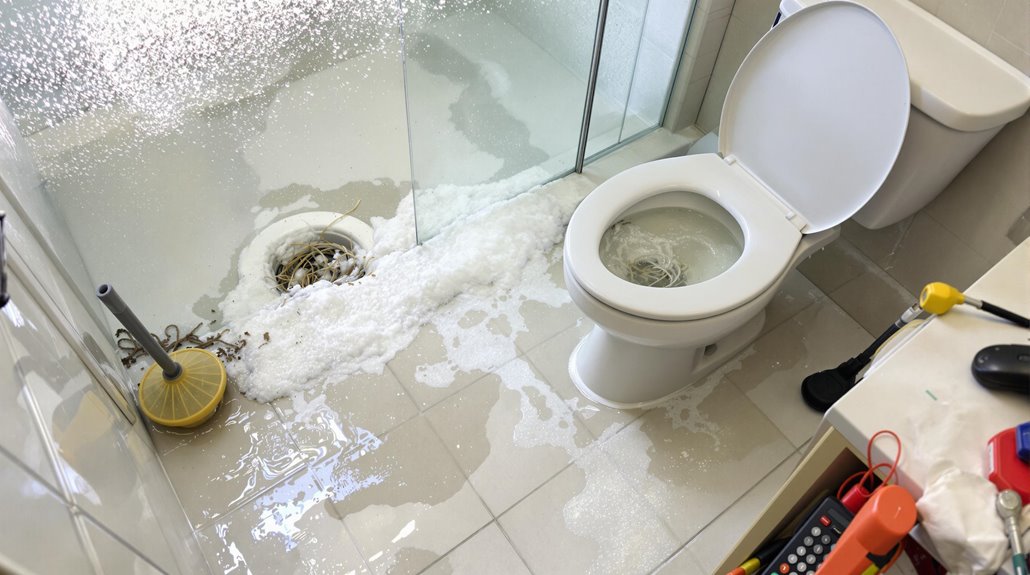
While proper maintenance helps prevent most plumbing issues, certain scenarios demand immediate expert intervention. When both a toilet and shower clogged simultaneously occur, it typically indicates a severe sewer main blockage requiring professional assessment.
This situation often signals an extensive plumbing emergency that can lead to hazardous sewage overflow and property damage if not addressed promptly.
Critical signs that require emergency plumbing services:
- Multiple fixtures backing up simultaneously, especially when lower-level drains are affected
- Standing water or sewage emerging from multiple drain points
- Gurgling sounds from drains combined with visible water backing up in fixtures
Homeowners should immediately shut off their main water supply and Contact Us for emergency service when these symptoms arise.
Professional plumbers utilize specialized equipment like hydro-jets and video inspection tools to diagnose and resolve complex sewer main obstructions effectively, preventing costly damage and potential health risks.
Long-term Solutions for Recurring Issues
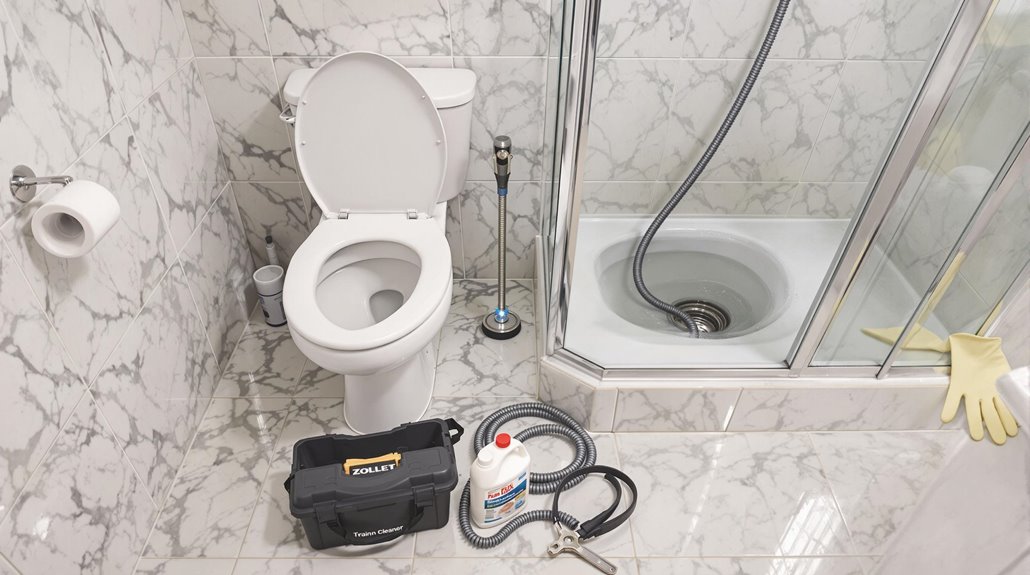
To prevent recurring toilet and shower clogs from disrupting daily life, homeowners must implement extensive preventive measures that address both immediate symptoms and underlying causes.
A thorough maintenance strategy begins with regular professional plumbing inspections to identify potential issues before they escalate. Installing mesh screens in shower drains effectively prevents hair and debris accumulation, while weekly hot water flushing helps dissolve grease buildup that can restrict water supply flow.
Homeowners should strictly prohibit the disposal of non-flushable items through the plumbing system, as these materials frequently cause simultaneous clogs in toilets and shower drains.
For older properties, scheduling periodic sewer line clean-outs is essential to maintain peak system performance. This preventive measure helps clear accumulated debris and mineral deposits that can lead to widespread drainage issues.
When implemented consistently, these solutions greatly reduce the likelihood of experiencing concurrent toilet and shower blockages, ensuring reliable plumbing function throughout the home.
Cost Considerations and Service Options
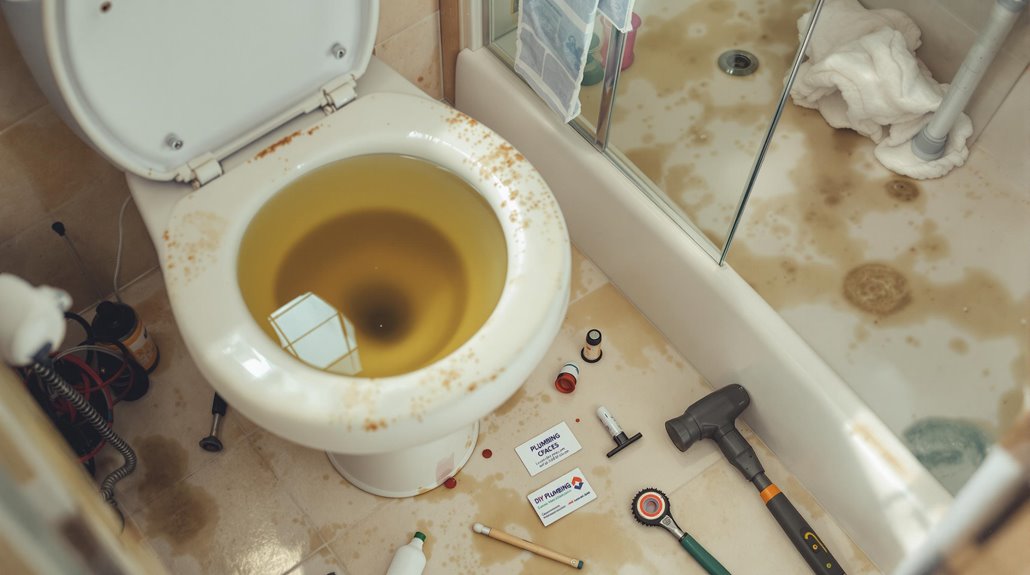
Professional plumbing services for toilet and shower clogs require careful cost evaluation, ranging from basic diagnostic fees to extensive repair solutions. When addressing simultaneous clogs, homeowners should consider both immediate and long-term financial implications while exploring available service options.
- Initial camera inspection costs average $295, with potential additional diagnostic fees of $150 if problems are detected.
- Free consultations from professional plumbers provide preliminary assessments without upfront costs.
- Financing programs like HERO offer payment flexibility for major plumbing upgrades.
The investment in professional plumber services often proves cost-effective when compared to repeated DIY attempts or delayed maintenance.
While the initial expense may seem significant, thorough solutions provided by qualified professionals can prevent recurring clog issues and more expensive repairs in the future.
Homeowners should inquire about maintenance packages and service warranties to maximize their investment and guarantee lasting results.
The Benefits Of Consulting A Public Adjuster
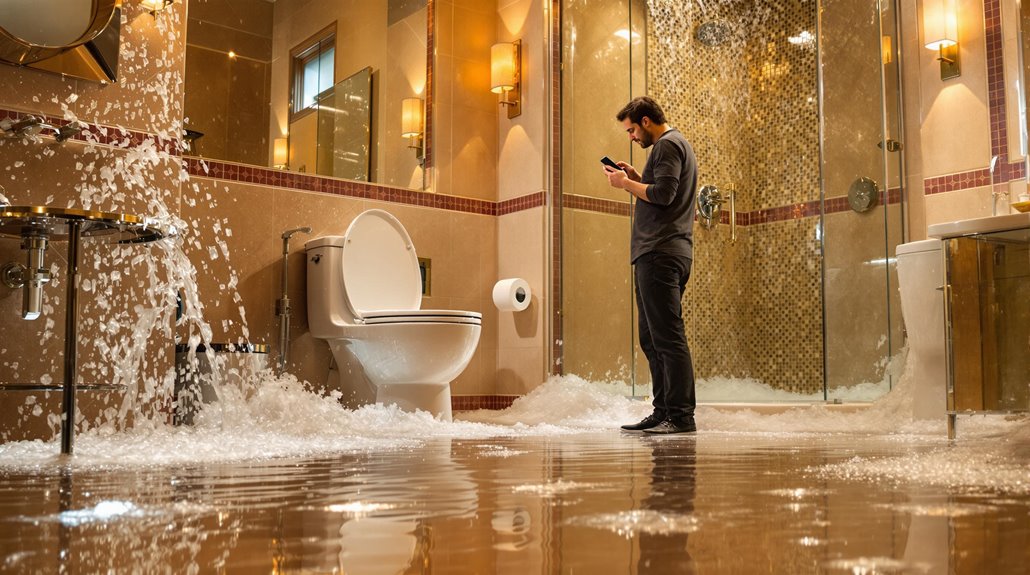
Consulting a public adjuster for extensive plumbing damage offers significant advantages, as these licensed professionals provide objective assessments and expert documentation of water-related claims.
Public adjusters streamline the claims process by meticulously evaluating damage patterns, preparing detailed documentation, and managing complex negotiations with insurance providers.
Studies indicate that policyholders who engage public adjusters often secure substantially higher settlements, with payouts reaching up to 800% more than those who handle claims independently.
Expertise In Insurance Claims
When dealing with extensive water damage from clogged toilets and showers, homeowners should consider enlisting the services of a public adjuster to maximize their insurance claims.
These licensed professionals possess thorough knowledge of insurance policies and can effectively navigate complex plumbing-related claims, especially when severe clogs in sewer systems lead to significant property damage.
- Public adjusters document and evaluate damage patterns from backed-up plumbing systems with precision, often securing settlements up to 300% higher than self-managed claims.
- They understand specialized coverage terms related to water damage repair and can identify all applicable policy benefits.
- These experts handle all communication with insurance carriers, allowing homeowners to focus on immediate repair needs while ensuring proper claim documentation.
The expertise of public adjusters proves particularly valuable when addressing extensive plumbing failures that require substantial restoration work.
Early involvement of licensed professionals is crucial for thoroughly documenting water damage and preventing potential complications that could impact your claim's outcome.
Objective Damage Assessment
Accuracy in damage assessment stands as a cornerstone of successful insurance claims for plumbing-related incidents. Public adjusters provide an objective evaluation of property damage, meticulously documenting the full extent of water-related issues that may result from major plumbing failures.
These professionals excel at identifying both obvious and hidden damages that could be overlooked during standard insurance assessments. Their expertise extends beyond surface-level observations, encompassing structural impacts, potential mold growth, and long-term effects of water exposure.
When dealing with complex insurance claims involving simultaneous toilet and shower clogs, public adjusters apply their technical knowledge to guarantee thorough documentation of all damages. Their systematic approach to assessment helps homeowners receive accurate compensation while maintaining professional objectivity throughout the claims process. With commission-based fees, public adjusters are incentivized to secure maximum settlement amounts for homeowners facing plumbing disasters.
Streamlined Claim Process
Professional assistance from a public adjuster delivers substantial advantages throughout the insurance claim process for plumbing-related damages.
When toilets are both clogged and shower drains malfunction simultaneously, indicating potential serious obstruction or repair needs in multiple parts of your plumbing system, a public adjuster's expertise becomes invaluable for proper claim documentation and settlement negotiation.
- Claims managed by public adjusters typically result in 20-50% higher settlements compared to self-managed claims.
- Professional adjusters streamline documentation requirements and expedite the entire claims process.
- Expert knowledge guarantees thorough coverage of all damage-related expenses, from emergency repairs to long-term solutions.
Public adjusters serve as dedicated advocates, managing complex claim details while allowing property owners to focus on addressing immediate plumbing emergencies and implementing necessary repairs, ultimately maximizing insurance coverage benefits.
Operating on a contingency fee basis, public adjusters charge between 5-20% of the final settlement amount, making their services accessible to property owners dealing with unexpected plumbing disasters.
Higher Claim Payouts & Settlements
The engagement of a public adjuster substantially increases the likelihood of securing ideal insurance settlements for plumbing-related damages.
When issues like a clogged vent system or damage from flushable wipes arise, public adjusters leverage their expertise to maximize claim recovery based on policy coverage.
Statistical evidence demonstrates that policyholders receive 20-30% higher settlements with professional adjustment assistance. Their extensive evaluation process identifies all compensable damages, including hidden issues where water might have caused structural deterioration.
Public adjusters' industry knowledge and negotiation skills prove particularly valuable in complex plumbing scenarios, ensuring thorough damage assessment and best possible compensation.
Their involvement expedites the claims process by managing insurance company communications, allowing property owners to focus on implementing necessary repairs and restoration measures.
Members of PCAN's network adjusters must maintain impeccable professional standards and undergo rigorous background checks to ensure the highest quality service for policyholders.
About The Public Claims Adjusters Network (PCAN)
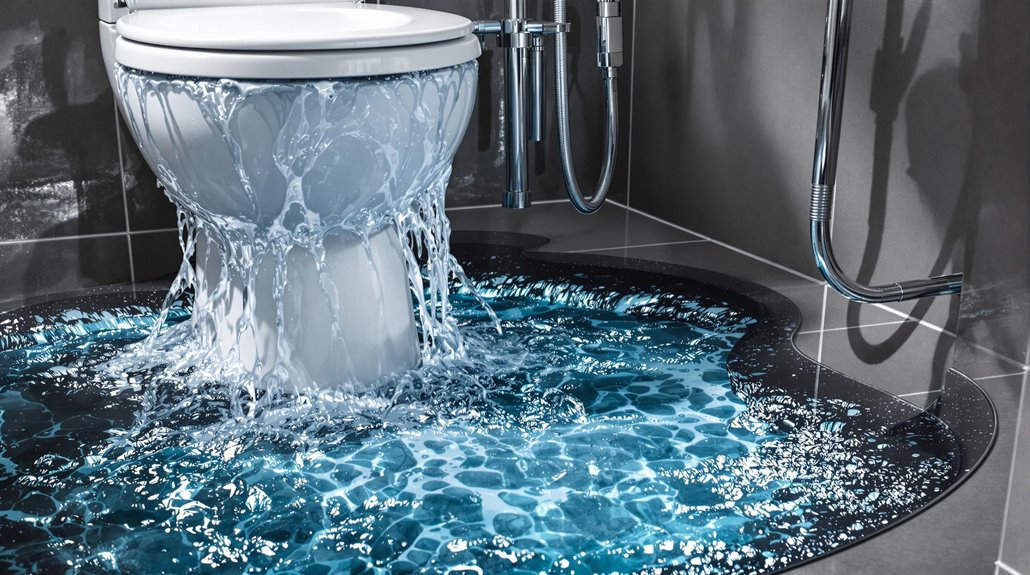
Serving property owners nationwide, the Public Claims Adjusters Network (PCAN) connects policyholders with top-tier licensed public adjusters across 40+ states.
This exclusive network maintains strict standards for membership, requiring adjusters to undergo intensive vetting and demonstrate expertise in handling property damage claims across 30+ categories.
Key aspects of PCAN's professional network include:
- Mandatory annual audits of licenses and complaint records to ascertain ongoing compliance
- Rigorous application and interview process for member adjusters
- Pre-verification of all adjusters' credentials and specializations
PCAN functions as an essential resource for property owners seeking expert assistance with insurance claims.
By maintaining high standards of ethics and professionalism, the network guarantees policyholders have access to qualified public adjusters who can effectively represent their interests.
This systematic approach to vetting and monitoring member adjusters helps maintain the network's reputation for excellence in claims adjustment services.
Frequently Asked Questions
Why Is My Toilet Clogged at the Same Time as My Shower?
Simultaneous blockages in toilets and showers indicate universal plumbing issues within the main sewer line. Common drain problems occur when shared drainage pathways become obstructed, affecting multiple fixtures connected to the system.
Why Is the Water Backing up From My Toilet and Shower?
While individual fixture clogs seem likely, simultaneous drainage issues in toilet and shower indicate a main sewer line blockage requiring professional plumbing solutions beyond routine home maintenance tasks.
How to Fix Clogged Shower Drain and Toilet?
Clear shower drain and toilet clogs by using a plumbing auger, followed by thorough plunging. For common causes affecting both fixtures, inspect main sewer line for potential blockages requiring professional intervention.
Why Are All My Drains Clogged at the Same Time?
Problematic plumbing patterns indicate main sewer line blockage when multiple drains clog simultaneously. Common causes include tree root intrusion, accumulated debris, or foreign objects obstructing shared drainage pathways.
